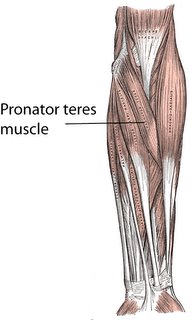Why righties screw better than lefties
Here's a little anatomy lesson that explains why right-handed people screw better than left-handed people. First, a little background on screwing.
Screws are essentially inclined planes or wedges wrapped around a cylinder or a cone. This combination of simple machines converts power in one direction to power at right angles to the thread and turns rotary movement to linear movement. When used as a fastener, say in wood, the material is pushed up the "inclined plane" of the screw thread by applying torque or twist to the screw via a screw driver or brace. The threads can spiral in either of two directions ("right-handed" or "left-handed"). By convention, screws spiral in a right-handed direction, because most people are right handed. Thus the conventional screw fastener is encoded human anatomy.
You generate torque with a screwdriver by turning your forearm. To see what muscles are involved you can do an easy experiment. With your hand palm downward on the edge of a flat table top, four fingers above and your thumb below the edge, make a right handed twisting motion against the resistance of the table. Take your left hand and feel your biceps muscle, the big muscle in your upper arm. You will feel it contract. The biceps is a big muscle. Here is a picture of it from Gray's Anatomy. In the picture it is the large two-headed ("biceps") muscle that attaches below your elbow on one end and to two points on your shoulder at the other end:
Screws are essentially inclined planes or wedges wrapped around a cylinder or a cone. This combination of simple machines converts power in one direction to power at right angles to the thread and turns rotary movement to linear movement. When used as a fastener, say in wood, the material is pushed up the "inclined plane" of the screw thread by applying torque or twist to the screw via a screw driver or brace. The threads can spiral in either of two directions ("right-handed" or "left-handed"). By convention, screws spiral in a right-handed direction, because most people are right handed. Thus the conventional screw fastener is encoded human anatomy.
You generate torque with a screwdriver by turning your forearm. To see what muscles are involved you can do an easy experiment. With your hand palm downward on the edge of a flat table top, four fingers above and your thumb below the edge, make a right handed twisting motion against the resistance of the table. Take your left hand and feel your biceps muscle, the big muscle in your upper arm. You will feel it contract. The biceps is a big muscle. Here is a picture of it from Gray's Anatomy. In the picture it is the large two-headed ("biceps") muscle that attaches below your elbow on one end and to two points on your shoulder at the other end:
However in going the other way (turn your wrist leftward) you'll find that no muscles in your upper arm contract. Instead we have a much smaller muscle in your forearm, the pronator teres, doing all the work:
In this picture the pronator teres is the smallish muscle that runs from the upper left attaching at the elbow to the mid right of your forearm. When it contracts it turns your forarm in the other direction. Because it is smaller and weaker, this is a less powerful motion. Of course on the left arm, we have the mirror image of all this. Note that the pictures are actually pictures of the left arm.
Thus screwing is easier for righties. Unscrewing is easier for lefties. Draw your own lessons.



<< Home